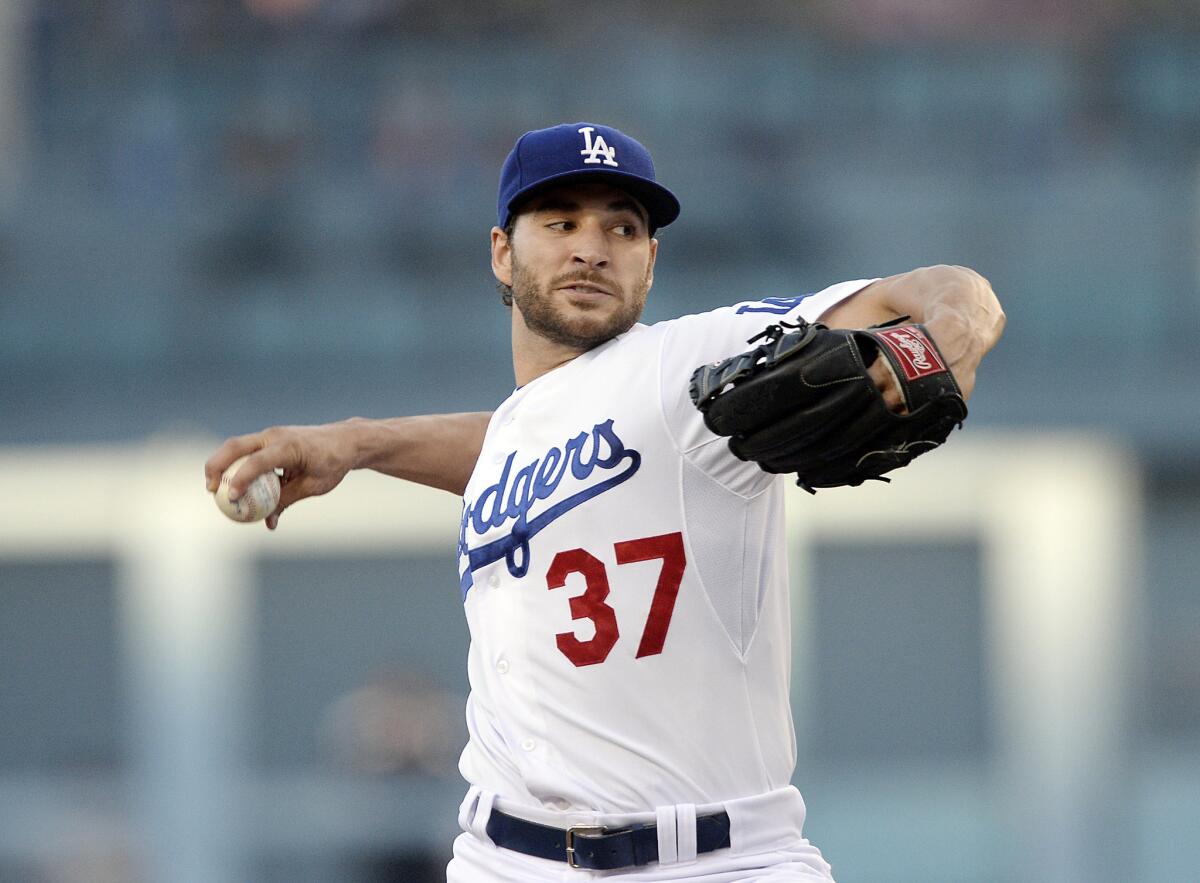Good feeling, middling results for Dodgers’ Brandon Beachy

Dodgers starter Brandon Beachy delivers a pitch against the Brewers in the first inning Saturday night, completing his return from a second ligament replacement surgery on his right elbow.
- Share via
For the first time in 690 days, Brandon Beachy stood behind a major league mound, tossed a rosin bag, and inhaled. There were many times he doubted he’d make it to this moment, and no one knew what to expect afterward, but now he dug into the mound and stared toward home plate.
He took the sign and let go.
For the first time since a second reconstructive elbow surgery, Beachy started a big league game Saturday, for the Dodgers against the Milwaukee Brewers. He pitched four innings, laboring at times, and gave up three runs on a bases-loaded double. He struck out two. The game ended after the deadline for this edition of The Times.
Where Beachy will fit into the Dodgers’ rotation is unclear.
“We have other options moving up coming out of the break,” Manager Don Mattingly said before the game. “But this may be a good indicator for him. Maybe he thinks he’s really ready and maybe he’s not. Maybe he thinks he’s ready and he really is. Tonight is just a game we’ll find out.”
Much about Beachy is a mystery, even to Beachy. The coaching staff and catchers still must adapt to his rhythms and learn to judge his stamina, something Beachy is still trying to get a feel for.
Before the game, Mattingly wondered what he would do if Beachy told him he could stay in to face another batter. He said he wouldn’t know how to respond.
“I don’t know if he really knows at this point,” Mattingly said.
An effective Beachy would give the Dodgers welcomed flexibility at the back of the rotation. Carlos Frias is on the disabled list and Mattingly hasn’t decided if he will return to the rotation or, if Beachy wins a spot, to the bullpen. Before an effective outing Friday, Mike Bolsinger had struggled.
The Dodgers front office has indicated it will move to acquire pitching before the trade deadline. Still, Beachy can pitch himself into a regular spot.
Just getting to Saturday was an accomplishment. Beachy underwent his first Tommy John surgery in 2012 and missed much of the 2013 season. Then, early in 2014, he felt more tightness. An ugly spring training start raised new fears and a new examination, which led doctors to, again, find significant ligament damage.
He needed a second reconstructive elbow surgery.
The list of pitchers who have returned from two Tommy John surgeries is short. One surgery requires a lengthy rehabilitation period, and it can take months or years before a pitcher regains his confidence and command of his delivery.
Beachy now faced an even longer rehabilitation period and an unknown outlook once his arm healed. The recovery process, he said, felt endless. He considered retirement.
“At times there was no light at the end of the tunnel,” Beachy said.
Each time, he resolved, “You can’t just give up when you don’t know. If you want something, you go for it.”
Beachy worked deliberately to ease his arm into form. He obsessed over bullpen sessions, Mattingly said, and took his time to feel right.
The risks of rushing were clear. The Oakland Athletics’ Jarrod Parker underwent a second elbow surgery around the same time as Beachy. After a pitch in a rehabilitation start earlier this season, Parker recoiled violently and grabbed his arm. Even on grainy minor league video, his elbow had visibly fractured.
Beachy said Parker’s setback didn’t alter his timeline, which he said was different from Parker’s from the start.
“We didn’t change anything due to any outside factors,” Beachy said.
His first pitch in almost 23 months was a 91-mph fastball, high and away for a ball. The at-bat ended in a sharp line-drive single.
After that he settled down. He wrestled with his command for much of the night, and his fastball didn’t crackle — it sat at about 90 mph and topped out at 93 — but his curveball was crisp.
In the third inning, he gave up a three-run double to Carlos Gomez just over the glove of left fielder Andre Ethier. That would account for all of his runs.
His night ended early, after 78 pitches. It wasn’t enough to provide a clear picture of where he fits on this team. But it was a start a long time in the making.
More to Read
Are you a true-blue fan?
Get our Dodgers Dugout newsletter for insights, news and much more.
You may occasionally receive promotional content from the Los Angeles Times.









